SASS® 2300
Wetted-Wall Air Sampler
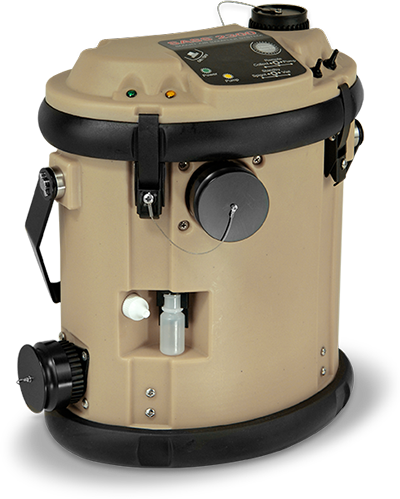
The SASS® 2300 Wetted-Wall Air Sampler extracts airborne pathogens, particulates, bacteria and spores in liquid form for later analysis. Its patented wetted-wall aerosol collection method earned U.S. Department of Homeland Security Certification under the U.S. Safety Act of 2002.
The SASS 2300 offers extremely long sampling protocols – up to several days – and unsurpassed monitoring capabilities in environments ranging from farmyards to hospitals to battlefields. Wireless control options and customizable sampling protocols extend its versatility.
In early 2020 during the early phases of the pandemic, the SASS 2300 gained international attention when used in a widely cited study of Coronavirus in a Wuhan hospital.
Download Datasheet Request a Quote
World Class Sampling Performance
A Track Record of Proven Performance
Successfully tested and used in subway systems, public health facilities, nuclear power plants, corporate mail rooms and poultry ranches for over 20 years.
Supports Long Unattended Sampling Periods
The SASS 2300 can operate unattended for extended time periods, from several hours up to even several days. Its patented technology maintains constant liquid levels.
Unrivaled Efficiency on Battery Power
Running at near-peak fan efficiency, the SASS 2300 offers the longest possible battery operating time, allowing extended sampling periods in the field.
- Features
- Applications
- Parts & Accessories
- Documents
- Operations
- FAQs
Features
Product Features
- Collection cycles may be many hours in length
- Liquid sample unaffected by ambient conditions
- Choose your own automated protocols
- Onboard automated sample vial filling
- Wireless operation and control option
- Convenient threaded inlet and outlet ports
- Long-life primary and rechargeable batteries
- Portable with impact and water resistant case
Applications
Applications
- Homeland security
- Military
- Academic research
- Food safety
- Power plants
- Public health and medical facilities
- Agriculture
- Indoor air quality
- Mailrooms
- Environmental
Parts & Accessories
Parts and Accessories
To request a price quote, check the box beside the desired items(s), fill out the contact form, and press Submit.
Please allow two business days for a reply.
Documents
Documents
- SASS 2300 Data Sheet
- Safety Data Sheet: SASS 2300/2400 Buffer Salts (P/N 7000-159-011)
- Product bibliography
- Guo Z. et al., Aerosol and Surface Distribution of Severe Acute Respiratory Syndrome Coronavirus 2 in Hospital Wards, Wuhan, China, 2020. Emerg Infect Dis. 2020;26(7):1583-1591.
- Tech Note: Decontaminating the SASS 2300
- Power Measurements and Battery Life Estimates
- Comparison Chart: SASS Air Samplers
- A Comparison of Portable Air Samplers
- SASS Series Collection Efficiency chart
- Candidate Disinfectants for Research International Products
- SASS 2300 technology used by Lawrence Livermore National Laboratory in their Autonomous Pathogen Detection System (APDS)
Operational Details
Operational Details
The SASS 2300 collects both particulates and water-soluble chemical vapors from the air. These materials are extracted from the sampled air and trapped in a small volume of liquid that can be removed at any time for analysis. Distilled water is typically the sample liquid of choice and no additives or surfactants are required for high efficiency. Trace aerosol concentrations can be amplified by extending the sampling time to hours or days.
Air is drawn in through a threaded adapter on the unit's exterior. This adapter allows the mounting of your own accessories such as flexible intake tubes, filters and nozzles. A built-in peristaltic pump can transfer liquid samples to an external analyzer for immediate analysis, or to a sample vial filling station mounted on the back of the unit. This filling station is convenient for dispensing all or a part of the liquid sample into a dropper bottle of the type used with lateral flow bioassay tickets.
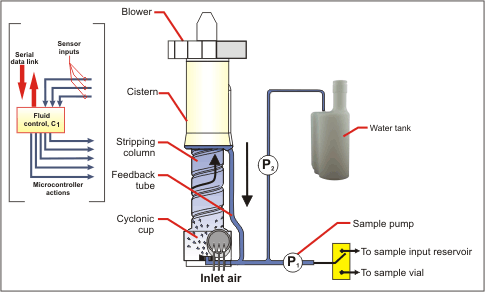
Fluid Control Subsystem
The particle extraction process involves intimate mixing of incoming air with re-circulating sample water. To prevent evaporation, liquid volume is monitored with a proprietary sensor attached to the water feedback tube. When the sample water inventory falls below a preset level, a microprocessor-controlled peristaltic pump meters a small amount of clean water into the re-circulation loop from an onboard water reservoir to bring the level back to set point. Water inventories can be maintained within a range of about 4 cc to 5 cc with an accuracy of a few tenths of a cc for periods of hours to days (U.S. Patent 6,532,835). Since the re-circulation loop does not use a mechanical pump, power consumption is minimized, delicate organisms are not damaged, and cleaning is simplified.
Samples may be removed at any time using an onboard peristaltic pump. When the unit is operated manually, air flow is stopped during the sample transfer process to allow fluid films to collect as a pool in the bottom of the unit. If the unit is being operated remotely via the serial digital link, air sampling may continue during the sample transfer process. The user can in either case elect to discharge the sample to an onboard sample vial or to a discharge spigot at the rear of the instrument.
The distilled water used by the SASS for sample collection is not generally compatible with analytical procedures used to identify any captured biologicals; most require some buffer such as phosphate-buffered saline. Sample vials for the SASS are provided with a lyophilized buffer that reconstitutes when the sample is pumped in to provide a liquid ready for direct application to lateral flow immunoassays such as the DoD Hand-held Assays (HHAs) or equivalent. Please see our Application Note,“Suitability of SASS 2300 Sample Vials and SASS 3010 Sample Vials for use with Hand-Held Assays,”for description of our test procedure.
Aerosol collection characteristics are similar to those of the SASS 2000, but with significant improvements in particle retention over long collection periods. Figure 2 shows the effect of water inventory on the concentration and total number of 1 micron particles in the water phase. From this Figure it can be seen that about 5 cc of water provides optimum performance. The effect of fluid charge is modest as long as very lean, low water charges are avoided.

The similar SASS 2000 system has been tested at a number of facilities including Dugway Proving Grounds, Aberdeen Proving Grounds, Lawrence Livermore National Laboratory, Battelle Columbus, and the U.S. Naval Research Laboratory (NRL). A test of nine 'personal' sampler designs was conducted at Dugway Proving grounds in April 1997 against airborne Bacillus globigii in a controlled atmosphere chamber. In these tests, the number median aerodynamic spore diameter was 0.9 microns while the mass median diameter was 2.9 microns. At that time, Research International's prototype system tied with two cyclone-based devices for highest concentration factor versus time.
A second set of tests was run at BIO911 in December 1997 in which 11 different samplers were examined. In the period between the two test series, Research International made several improvements to the design that reduced water inventory and made the interior less likely to trap particles. In these tests, the SASS 2000 came in second, performing slightly lower in overall performance than the front-runner, but both it and the first-place system were substantially better than other systems tested. Its favorable performance is particularly notable since the number one system weighed four times as much and consumed 42 times more electric power.
Detailed examinations of SASS 2000 capture efficiency have been performed by Lawrence Livermore Laboratory and Battelle Columbus over the past five years. A compilation of these test results, plotted as capture efficiency versus particle size, is provided in Figure 3. Finally, in portable air sampler tests performed by Battelle Columbus in 2004, no other portable unit was found to be more efficient that the SASS 2000 series.
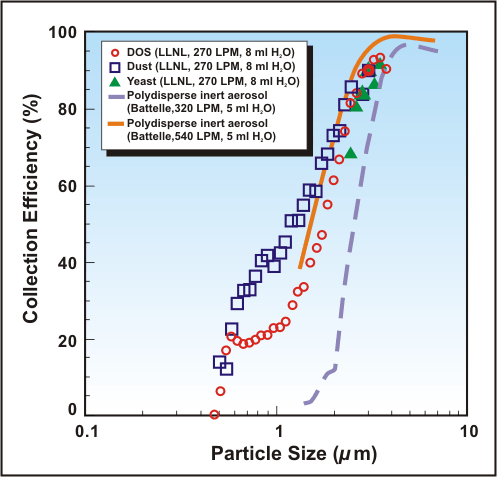
Software Interface
The SASS 2300 air sampler is microcontroller-based and can function as a stand-alone unit or connected to other sampling, detection or communication systems via RS-232 or wireless link. Purpose-designed software allows for streamlined integration with Research International's RAPTOR and BioHawk biodetectors. The extensive use of microcontroller-based circuits allows overall system operating characteristics to be easily tailored to customer requirements. Reprogramming of sampler operation may be performed at any time over the RS-232 link without having to disassemble the unit.
Customizeable Firmware
Users can modify to their liking how the SASS 2300 collects and processes samples using the PC-based software supplied with the system. User-defined protocols can be stored in a PC and the sampler operated from that PC or the protocols can be downloaded to the 2300’s memory. The 2300 will then follow the downloaded instruction set automatically each time it is turned on, even if not connected to a PC.
Sampling Protocols
Parameters are set on the Automatic Mode screen with radio buttons and text boxes as shown in Figure 4. For example, selecting Fan off while pump on will cause the fan to turn off while liquid is being pumped out of the cyclone. If you instead choose Fan on while pump on, the fan will continue to run while the cyclone is being pumped out.
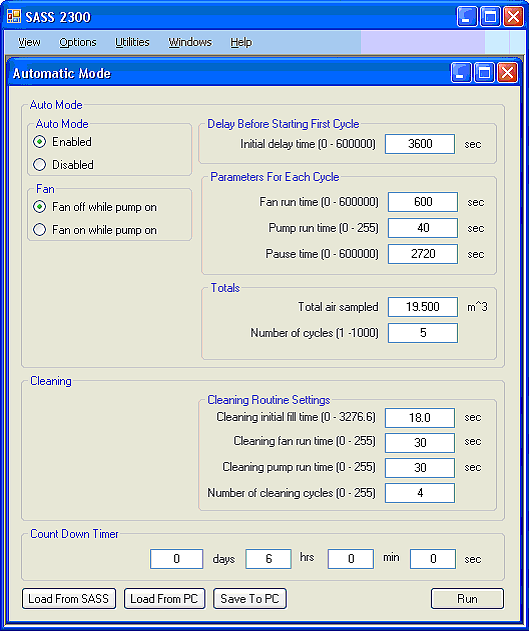
In the upper right hand corner of the Automatic Mode screen is the Delay Before Starting First Cycle text box. A value placed in this box will cause the air sampler to pause before starting the first sampling cycle. This is useful for example if you have stirred up dust during set-up and want the dust to settle before sampling starts. Other text boxes allow you to set (1) how long the fan is on; (2) the amount of time the sample discharge pump is on; (3) the amount of pause time there is between samples; (4) and the number of sampling cycles.
The Cleaning group of controls shown in the bottom of Figure 4 allows the user to run an automatic cleaning protocol at the end of each fan/pump cycle. This is a procedure wherein the sampler is repeatedly flooded with excess fluid and the fan used to circulate this fluid before it is pumped out, thereby flushing contaminants collected during the previous sampling cycle. If no cleaning cycle is needed, simply enter ‘0’ in the Number of cleaning cycles box.
The Cleaning Routine Settings group allows you to set the parameters for this routine. The Cleaning initial fill time allows the user to set the amount of time that the cyclone is filled with fluid. This fill time can be set in tenths of seconds and occurs immediately upon the fan starting. The Cleaning fan run time and the Cleaning pump run time allow the user to set the fan and pump time for the cleaning routine. The Cleaning number of cycles allows the user to repeat the fan/pump cycle a number of times. Typical values for a cleaning protocol are shown in the Figure.
Expert Users
For users who need even more control over the SASS 2300 or need to integrate it into a proprietary system, the Operating Manual provides the user with a set of over 60 ASCII commands that can be sent over the serial data link to either control or interrogate the sampler.
Main Window for Remote PC Operation
If the SASS 2300 is being operated remotely from a PC by wire or wireless connection, the main program window in Figure 5 continuously shows key operating parameters associated with the sampler. A large graph displays the liquid sample volume circulating in the cyclone. The vertical labels on the left side of the graph represent the raw counts from a liquid level detector inside the SASS 2300 while the vertical labels on the right side represent the corresponding milliliters of liquid circulating in the cyclone. The signal from the liquid level detector is displayed in red and normally oscillates about the set point that is represented by a blue horizontal line.
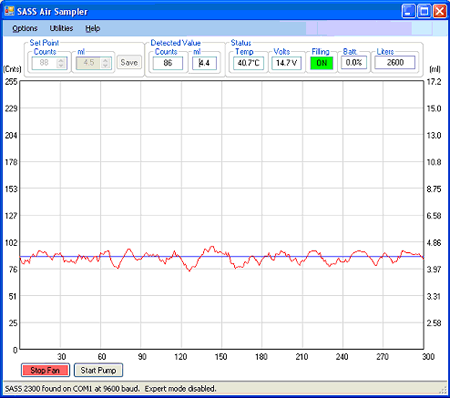
The upper left of the main window shows the Set Point information. The set point is the desired operating volume for the cyclone that the microcontroller-driven electronics in the SASS 2300 maintains while the fan is running, by adding make up fluid as it evaporates or is pumped out.
To the right of the Set Point group in Figure 5 is the Detected Value group of controls. These controls display the reading from the internal liquid level sensor that is used to maintain the liquid volume in the cyclone. This is the value plotted by a red line on the graph.
TheStatus group in the upper right of Figure 5 shows several system operating parameters. The real-time internal electronics temperature is displayed in the Temp field, in degrees Celsius. The temperature sensor that generates this reading is located on the SASS 2300’s internal PC board. The operating voltage is displayed in the Volts field. The Filling field displays the status of the pump that is used to fill the cyclone with makeup fluid when the fan is running. This pump turns on momentarily for a few seconds at a time to assure that the proper liquid level is maintained in the cyclone. When this pump is off, the Filling field will display the word OFF with a white background. When the pump is on it will display the word ON with a bright green background. The Batt field displays the percentage of battery life remaining. The Liters field displays the number of liters of air that have been sampled since the fan was last turned on. If you are running in Automatic Mode (Figure 4) this field will display the cumulative liters of air sampled since these operations were started.
FAQs
Frequently Asked Questions
- Perhaps most importantly, the device incorporates a patented method of maintaining the same physical amount sampling water in the device, independent of collection duration, air temperature, or relative humidity. This means that the device can be used in situations where it is desirable to sample for a period of several hours. In addition to permitting wet sampling over long periods, any aerosol target in surrounding air will be continually concentrated over time. For example, collecting for 1 hour will produce a concentration of the target species that is 12X higher than if only a 5 minute sample was taken. Other samplers resort to dry collection and later re-hydration to accomplish long-term collection. This may kill many delicate organisms.
- The SASS 2300 only requires a liquid sample volume of 4 to 6 ml. This is considerably smaller than some competing devices and results in higher target organism concentrations in the sample fluid.
- The SASS 2300's sample fluid is pure water. No additives are required. This can be an advantage for PCR and other analysis methods that may be degraded in performance because of the presence of salts and surfactants in the sample solution.
- The SASS 2300 can operate continuously for 24 hours. It is the longest-operating high volume portable collector on the market.
- The wetted-wall cyclone technology used in the SASS 2300 captures micro-organisms gently, minimizing damage to them and increasing viability of captured dehydration-sensitive organisms.
- The SASS 2300 is reprogrammable. A software package is provided with each unit that allows user customizing of air sampling rate, start time and collection time, and the setup of periodic sampling protocols. It is the most programmable sampler on the market.
- The SASS 2300 may be controlled remotely through a Bluetooth wireless link from over 1000 feet away.
The fan is operated at a constant RPM, so the airflow is constant, independent of battery or mains voltage. Of course, if you took it onto a high mountain where the air density was much different, there might be a small change in the actual flow rate.
It is calibrated with an orifice-style flowmeter at the factory before shipment. If you compare it with some other type of flowmeter, you have to be careful that the flowmeters airflow resistance does not affect the reading, that is, slow the flow of air down. Our calibration flowmeters have a pressure drop of only about 0.25 cm of water at 300 liters/minute. The overall pressure difference driving air through the SASS 2300 is only about 5 to 6 cm of water. That is why it can operate on a battery for such a long time. It has been designed to very efficiently use the air capability of the fan.
The fan is operated at a constant RPM, so the airflow is constant, independent of battery or mains voltage. Of course, if you took it onto a high mountain where the air density was much different, there might be a small change in the actual flow rate.
You cannot replace the make-up water in the make-up reservoir with PBS, since it will result in increasing sample salinity with long operating time. We maintain a constant level of sample water in the collector by periodically adding small increments of distilled water to it. However, you could inject PBS into the sampler's inlet throat initially, which would provide the saline environment you want, and then the distilled water automatically provided by our unit would maintain the sample level. If you do this, you might want us to initially set the system up for a 'dry' start-up. Normally, the unit injects a full charge of distilled water immediately upon turn-on to minimize start-up time. With the proposed scenario, you would be providing that start-up fluid charge manually. By the way, the PBS cannot have surfactant in it, since an excessive amount of foam would be created during operation. At least one other customer is doing something like this, but they have not confided details of their procedures to us. You might also want to wash the interior of the SASS from time-to-time so that salts did not build up near the fan entrance, or inside the fan.
It is likely that the salts would also disappear at roughly the same rate - perhaps faster. You might visualize the situation as being due to sub-micron droplets carrying salts (produced during the spraying process) that are not captured and are instead discharged out the exhaust. The SASS 2300 has a secondary rotor structure that prevents larger droplets from exiting and being a source of pathogen spreading, but it will not be effective on the sub-micron droplets. Prolonged operation may lead to a buildup of salts in the secondary rotor structure that may get into the bearing and either physically stop it from rotating or corrode it. Occasional disassembly and washing with DI water should reduce the risk of that happening.
Some other customers have injected various agents into the collection water, but we do not have access to their results data. There are two different scenarios here. If you just injet buffer into the sampler throat and have DI water in the reservoir, then the buffer concentration will gradually fall with time. If you put it into the reservoir, then the concentration will increase fairly rapidly. The water at 50% RH and 25C evaporates at a rate of about 0.8 cc/minute, which should dominate over any loss mechanism. Since you have a fixed volume Vsass of (let's say) 4.5 cc, there will be a linear increase in buffer concentration as
[S(t)] = [s]( 1 + Vdot x t/Vsass)
Where [S(t)] is the salt concentration as a function of time in minutes in the 2300, [s] is the concentration of salt in the reservoir, Vdot is the make-up water introduction rate (around 0.8 cc/minute), Vsass is the constant fluid volume in the SASS, and "t" is the operating time in minutes.
The concentrator can be used with or without the software. You do not need to be connected to a computer. The software is only necessary if you want to change any operating characteristics (such as fluid sample size) from the default levels set at the factory. The software is also useful where the sampler is used as part of an automated, computer-controlled system. Otherwise, the SASS 2300 is completely self-contained and may be operated with the switches on the instrument.
With the standard BA5590/U 15 Ampere-Hr primary battery, the unit will run continuously for about 20+ hours. If you use the AC electrical adapter supplied with the unit, there is no limit to operating time, insofar as electric power is concerned.
The unit automatically adds distilled makeup water from an onboard reservoir that holds about 1200cc, minimum, to offset evaporation. The evaporation rate of course varies with relative humidity and temperature, but as a first approximation, assume that you will evaporate 0.8 cc of water per minute. This means that you can operate continuously for about 24+ hours before the reservoir is exhausted of water. If you want to operate continuously for a longer period, you will need to supplement the internal water reservoir, or add water periodically. For one customer the sampler was fixed in location and we provided a supplemental reservoir that allowed 7 days continuous operation.
It is made of shock-resistant plastic and is not autoclavable. Sterilization is commonly done using bleach or an oxidizing solution such as hydrogen peroxide. Since it is made in part of plastic components, we do not recommend you use organic solvents without first asking us if they will harm the unit.
You can recover a sample at any time. The only downside to collecting a sample while the SASS is operating is that the sample may be a combination of water and air, and the amount of liquid may vary somewhat from sample to sample.
The maintenance of a constant fluid sample size is by sensor feedback. We use a proprietary sensor and algorithm in the SASS's electronics to monitor the fluid level, and add water as needed.
The instrument is shipped to you in its carrying case, inside a cardboard box. It is reasonably tough, and could just be shipped back in a cardboard box with packing foam. Or you could ship it back as received, if you prefer.
The BioLink is convenient if you want to control, operate or monitor the SASS from a remote location, and don't want to have an RS-232 cable between the SASS and the control computer. It is an accessory, and is not needed for basic operation.
Gallery
Related Products




